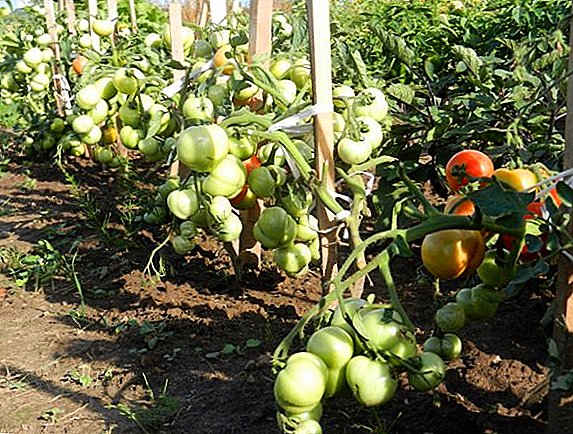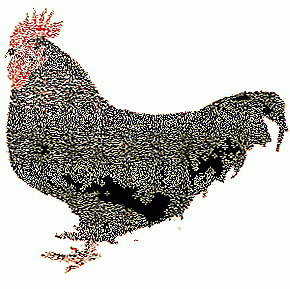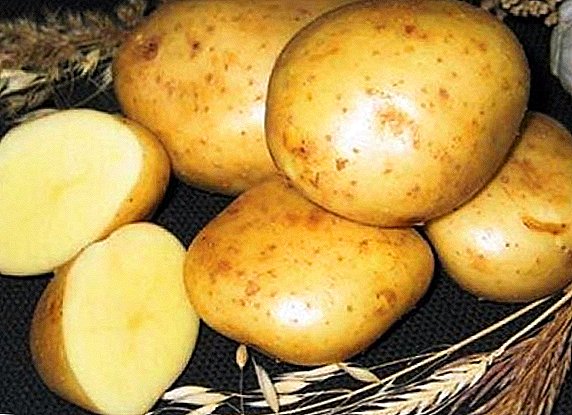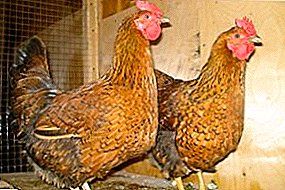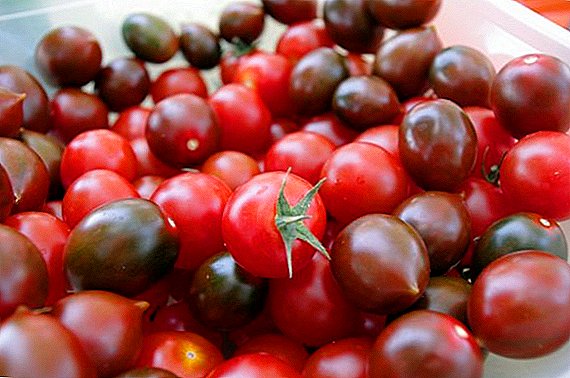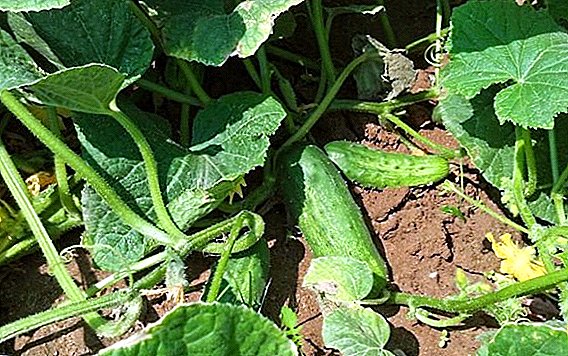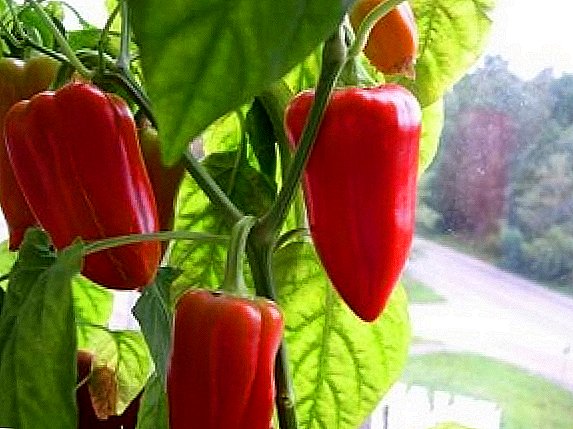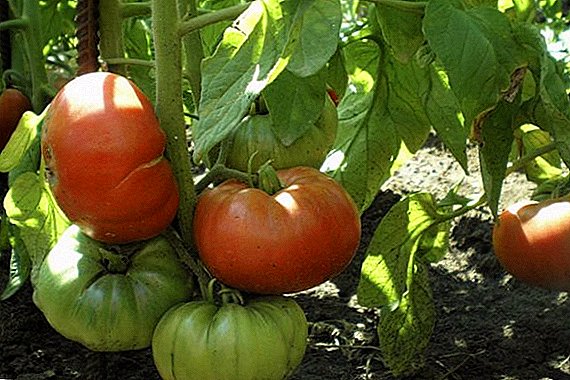 Growing tomatoes on their own private plot is a national tradition of domestic summer residents. But those who do not have the ability to keep track of their beds on a daily basis often face the fact that the harvest does not justify the efforts put into it because of pests, drought, or simply the wrong garter of the bushes. This category of gardeners should pay attention to a very unpretentious and easy to care variety of tomatoes with the promising name "Early Love".
Growing tomatoes on their own private plot is a national tradition of domestic summer residents. But those who do not have the ability to keep track of their beds on a daily basis often face the fact that the harvest does not justify the efforts put into it because of pests, drought, or simply the wrong garter of the bushes. This category of gardeners should pay attention to a very unpretentious and easy to care variety of tomatoes with the promising name "Early Love".
Variety description
"Early Love" is a Russian variety of tomatoes. He was bred by Altai breeders in 1999, and therefore well known to domestic gardeners. Initially, the variety was intended for cultivation in personal household farms, it is not productive enough for industrial production.
As you know, tomatoes are divided into indeterminate (growing throughout the season) and determinant (which stop their growth after reaching a certain height). "Early love" is usually referred to as determinant varieties, however, some agronomists believe that it would be more correct to call this plant semi-determinant, because its bushes, before stopping, have time to achieve quite impressive sizes.  Distinctive features of the variety are as follows:
Distinctive features of the variety are as follows:
- the height of a bush can reach two meters, although in conditions of too warm climate, its growth usually stops at the level of 170-190 cm, and in the absence of good care it barely reaches 1 meter;
- bush is not standard, potato type, that is, consists of a thin stalk and several brushes;
- the foliage is dense, the leaves themselves are small or medium in size, standard shape and bright dark green color;
- the inflorescence is simple, the stem has joints, the ovary is formed in the form of a brush with the number of fruits from four to five.
Check out the most popular early tomato varieties.
Among the absolute advantages of a variety that distinguishes it favorably from the "competitors" are the following:
- no need for pinching;
- early ripening;
- high resistance to many pests and fungal infections, in particular, to late blight;
- universal purpose of fruits: suitable for eating raw, salting the whole and making juice;
- high taste of tomatoes;
- good storage capacity and crop transportability;
- unpretentiousness, resistance to temperature fluctuations and drought.
 Not devoid of grade and significant shortcomings. These include:
Not devoid of grade and significant shortcomings. These include:- low yield;
- the need to tie up and shape the bush;
- weak shoots;
- high demands on feedings during the growing season.
Fruit characteristics and yield
Variety refers to the early ripening: the period between the emergence of the first seedlings and the harvest is from 90 to 100 days.
Characteristic of fruits:
- have a rounded shape, small ribbing and not too high density of the skin, which, however, is not susceptible to cracking;
- at the stage of maturation, light green, then they become bright red or crimson;
- the inner part consists of four or more chambers in which there are seeds;
- the flesh is sweet and sour, juicy, dense and fleshy.
 The size of the tomatoes are small, their weight varies between 80-95 g, but they have excellent taste.
The size of the tomatoes are small, their weight varies between 80-95 g, but they have excellent taste.
Did you know? The smallest tomato from the category of cherry weighs only 1 g, while the maximum recorded weight of this vegetable was about 3.8 kg (to be more accurate - 8.41 lbs). This giant was listed in the Guinness Book of Records in 2014.The fruits of this variety are great for salads, but can also be used for harvesting for the winter, which is not typical for early ripe tomatoes. Most often they are salted in barrels, canned or pressed on juice, tomato paste, homemade ketchup, adjika, etc.
 Nevertheless, such an approach to the use of a variety cannot be called rational: “Early love” has a rather modest yield - even if ideal conditions are created for growing, it is rarely possible to remove more than 2 kg of fruits, which, given the recommended planting scheme, gives about 5- 5.5 kg yield per square meter. With such indicators, tomatoes are best planted in small quantities in order to be able to taste delicious fruits at the beginning of the season, and to use higher and more productive varieties for harvesting.
Nevertheless, such an approach to the use of a variety cannot be called rational: “Early love” has a rather modest yield - even if ideal conditions are created for growing, it is rarely possible to remove more than 2 kg of fruits, which, given the recommended planting scheme, gives about 5- 5.5 kg yield per square meter. With such indicators, tomatoes are best planted in small quantities in order to be able to taste delicious fruits at the beginning of the season, and to use higher and more productive varieties for harvesting.Selection of seedlings
The best way to get quality seedlings is to grow them yourself. But if there is no such possibility, it is possible to purchase and ready, it is very desirable to have for this purpose a “trusted source”, that is, a well-known person who values his reputation and will not sell deliberately low-quality goods.
Important! Experienced farmers will always find the opportunity to give the seedlings a fresh and attractive look, using various tricks - artificially accelerating growth, masking existing diseases, etc.
Choosing seedlings, you need to understand that even a specialist will not be able to distinguish by appearance the variety of the future plant. Therefore, the rules for choosing seedlings are the same for all tomatoes, and it remains to rely only on the honest word of the seller regarding their varietal affiliation.  So, you can buy tomato seedlings, in which:
So, you can buy tomato seedlings, in which:
- about the same size;
- bush height does not exceed 30 cm (less possible);
- stem diameter is about 0.5 cm;
- the stem and leaflets are strong, not wilted and not elongated;
- branches not too long (the first sign of the absence of hardening);
- leaves, including cotyledon, dark green, fresh and not dried;
- the number of leaves, excluding cotyledons, ranges from three to six;
- there are no flowers (the presence of a flower brush is not a problem, even if it is good, but the flowers should not be revealed);
- There are no signs of damage, breakage, torn leaves, rotting, blackening, yellowing, drying, pest larvae (it is necessary to inspect the inside of the leaf) and other problematic points;
- roots are not open (it is better to buy seedlings in separate cups).
Video: How to choose the best seedlings If at least one of the bushes presented for sale does not meet any of the specified criteria, this indicates a violation of its cultivation technology. It is not necessary to select healthy bushes, choose another seller.
Important! The use of nitrates to stimulate seedlings is indicated by the unnatural color of the leaves (literally emerald), an even more obvious sign - the leaves twisting down.
Growing conditions
Tomato "Early Love" can be grown both in open ground and in greenhouses.
The variety produces the best yields in warm areas: the southern regions of Russia, Ukraine, etc., but under the film it feels great in the middle lane. In more severe climatic conditions, "Early Love" should be planted only in closed and insulated greenhouses.  For the cultivation of any varieties of tomatoes should choose the most sunny areas, because in the shade the fruit of this culture is very slowly picking up color, and for the early variety it is completely unacceptable, since it completely eliminates its main advantage - the soonest harvest. Besides, Grown in the shade tomatoes are usually noticeably sour.
For the cultivation of any varieties of tomatoes should choose the most sunny areas, because in the shade the fruit of this culture is very slowly picking up color, and for the early variety it is completely unacceptable, since it completely eliminates its main advantage - the soonest harvest. Besides, Grown in the shade tomatoes are usually noticeably sour.
Strong differences between day and night temperatures, as well as a dramatic change in the weather in general, tolerate tomatoes very hard, and although it is believed that "Early Love" is resistant to such an ordeal, you should not flatter yourself - this is just a little higher security before by some other varieties.
The temperature conditions for the thermophilic "Early Love" are as follows:
| The stage of development of tomato "Early Love" | Temperature readings, + ° C | |
| Night | Daytime | |
| Seed germination | 20-22 | 25 |
| The first week after emergence | 12-15 | 15-17 |
| Seedling formation | 18-20 | 20-22 |
| Transplanting (sowing) in open ground | 15-16 | 20-25 |
| Flowering and fruiting | Not below 15 | Not higher than 35 |
| Growth stop threshold | 10 | 10 |
| Invalid temperature minimum | 0 | 0 |
The optimum air humidity for growing a variety is 45-60%. If this indicator is exceeded, the probability of the fungal diseases of the plant increases dramatically, too dry air leads to the drying of the green part of the bush, first of all the leaves and flower brushes.
Tomatoes prefer sandy or loamy neutral soil. The optimum pH level is in the range from 5 to 6, the maximum allowable is 6.5.
Seed preparation and planting
You can grow "Early Love" in two ways - through seedlings and by direct sowing in open ground. The first method for early tomatoes is more preferable, because it allows you to get a harvest at least a month and a half earlier.
Important! Seeds of expensive hybrids from Holland, Germany and other European countries are planted in the ground without any preparation, even they should not be soaked. All necessary procedures with planting material have already been carried out by the manufacturer. This rule does not apply to domestic varieties: in order to get healthy and hardy bushes, seeds must be pre-sorted, disinfected, germinated and tempered.
Seeds are sorted as follows:
- A pinch of salt is poured into a glass of water at room temperature and mixed until completely dissolved.
- Then the contents of a bag of seeds are poured into the water and shaken well.
- Seeds that have not fallen to the bottom for seven minutes and continue to float on the surface are carefully removed and discarded, because the embryo has already died in them.
 For the prevention of disease, seeds of tomatoes are usually kept in a disinfectant solution, for which you can use:
For the prevention of disease, seeds of tomatoes are usually kept in a disinfectant solution, for which you can use:- "grandmother's methods" - potassium permanganate solution, aloe juice, etc .;
- modern drugs, for example, Fitosporin, which not only destroys pathogenic microflora, but also stimulates the development of the future plant, which is particularly relevant for the low-yielding variety "Early Love". 4 drops of the preparation are diluted in a glass of slightly warm water, seeds are placed in this water for 24 hours and then immediately planted.
 It is necessary to plant "Early Love" on seedlings around the end of March so that by the time of transplantation into the open ground the bushes do not outgrow.
It is necessary to plant "Early Love" on seedlings around the end of March so that by the time of transplantation into the open ground the bushes do not outgrow.
Important! By the time of achievement of optimal indicators for planting in open ground, seedlings should form no more than 6-7 true leaves and preferably the first flower brush. With the observance of the cultivation technology, this process takes 60-65 days.
The landing process is as follows:
- The prepared container (the best option is a cassette for seedlings) is filled with the prepared soil mixture by about 2/3, then the germinated seeds are laid out directly on the soil surface, and a thin, no more than 10 mm layer of soil mixed with peat is poured over the soil.
- Before germination, the container is covered with a film, after emergence of shoots the shelter is removed, and the seedlings are moved to a cooler place for a week.
- After the formation of the first pair of true leaves, the seedlings dive into separate cups and grow to the desired stage.
- Tomatoes should be planted in a prepared, dug, cleared of weeds and a fertilized bed to a depth of 25 cm. The recommended planting scheme is three bushes per square meter.


Read about the rules for planting tomatoes in open ground.
Maintenance and care
Immediately after the landing, "Early Love" needs a lot of moisture:
- If the weather is dry, young seedlings should be watered regularly, and when the bushes are finally strengthened, the number of irrigations can be reduced (as already mentioned, the variety is designed to tolerate short breaks in irrigation normally).
- To retain moisture in the roots, you can use the hilling method, "Early Love" responds to such a procedure with great gratitude.
- At the moment of the beginning of the setting of the fruits, it is necessary to water the "Early Love" at least every other day, keeping this regime until the end of fruiting.
- The drip irrigation system allows you to make this process as economical as possible in terms of water consumption and labor costs. In addition to the lack of need to do the irrigation itself, this technology also makes the loosening procedure unnecessary, which is mandatory for regular irrigation in order to avoid drying out and cracking the soil. Another advantage of drip irrigation is the ability to irrigate at any convenient time, including a bright sunny day, while ordinary irrigation under the sun will instantly destroy tomato bushes.
Important! It is estimated that the drip irrigation system allows to reduce water consumption by at least 30%, maximum by 50%. At the same time, not less than 90% of the water used is directed directly under the root of a cultivated plant, without moistening the nearby soil and not “encouraging” the weeds to grow lushly.If tomatoes are grown in a greenhouse, you should regularly ventilate the room, as high humidity threatens the seedlings with various fungal infections.
 Airing greenhouses Weeding is a must for tomato cultivationHowever, modern technologies also come to the aid of lazy (or very busy) summer residents.
Airing greenhouses Weeding is a must for tomato cultivationHowever, modern technologies also come to the aid of lazy (or very busy) summer residents.Familiarize yourself with the agricultural practices of growing tomatoes in the greenhouse.
If, before planting, we cover the bed with black agrofibre and plant bushes into previously prepared cuts in the fabric, the weeds will not grow through the dark matter, and the bed will be absolutely clean. In this case, drip irrigation can be placed directly on top of the fiber: it is perfectly permeable to water, and the irrigation tapes will not be contaminated from contact with the soil. Another way to avoid weeding is mulching the soil around the bush.  For these purposes, you can use straw, peat or needles, it is only important that the parasites' larvae, which can very quickly destroy the bush, are not kept in such material.
For these purposes, you can use straw, peat or needles, it is only important that the parasites' larvae, which can very quickly destroy the bush, are not kept in such material.
Did you know? A nightmare for any farmer who invests a huge amount of work and love in the cultivation of sweet and healthy tomatoes, is the world-famous La Tomatina. This strange holiday is arranged every year in Spanish Valencia and consists in the fact that the local residents, having united with the tourists who specially come here from all corners of the globe, throw each other in the week ... ripe tomatoes. As a result of such bacchanalia, an average of 145 tons of this vegetable is consumed. For reference: this amount is enough to fully satisfy the annual rate in tomatoes 15-18 thousand people!
During the growing season, “Early Love” should be fed several times with mineral fertilizers with a high content of potassium and phosphorus, but nitrogen fertilizers should not be applied. After the start of fruiting, complex mineral fertilizers are used.
Without garter "Early love" will not give the desired harvest, as thin branches with the growth of the fruit just begin to fall to the ground. You can use separate pegs for each bush, but if the bed is large, it is better to think over the general design for the garter beforehand. To form the "Early Love" should be in 2-3 stalks. If one main trunk is left on the bush, fragile branches will be injured under the weight of tomatoes, the bush will start to hurt, and the crop will give a low one.
To form the "Early Love" should be in 2-3 stalks. If one main trunk is left on the bush, fragile branches will be injured under the weight of tomatoes, the bush will start to hurt, and the crop will give a low one.
Disease and pest prevention
Proper agricultural technology plus the initial resistance of the variety can be expected that "Early Love" will have time to grow off without undergoing an invasion of pests or fungal infections. The main reasons why these problems arise are:
- high humidity;
- watering over the leaves, especially during the sunny time of the day;
- violation of the rules of crop rotation (long-term cultivation of tomatoes or other plants of the family of solanas in the same place);
- lack of ventilation (if we are talking about growing tomatoes in the greenhouse);
- insufficiently fertile soil;
- ignoring the requirements for disinfecting seeds;
- the use of poor-quality soil when planting seedlings;
- Acquisition of seedlings already infected with diseases or pests.
 Taking into account all these requirements, in essence, is the prevention of diseases and pests in tomato "Early Love". But, unfortunately, it is not always possible to completely protect a plant from unpleasant surprises.
Taking into account all these requirements, in essence, is the prevention of diseases and pests in tomato "Early Love". But, unfortunately, it is not always possible to completely protect a plant from unpleasant surprises.
Below are the most characteristic of them, as well as examples of drugs that will solve the problem.
| The name of the parasite (disease) | The name of the drug to fight (treatment) |
| Colorado beetle | "Prestige" |
| Gourd aphid, thrips | "Bison" |
| Whitefish, moth, sawfly | "Lepidocide" |
| White fly | "Confidor" |
| Spider mite | "Malathion" |
| Brown rot (fomoz) | "Hom" |
Harvesting and storage
Harvest the variety "Early Love" should be only after full maturation (redness) of the fruit. In principle, the rind of tomatoes, as the originator of the variety indicates, makes it possible to store and transport it for a sufficiently long time, with only one condition mentioned - the provision of a low temperature.
Did you know? Recent studies by French scientists have shown that the maximum amount of nutrients in a tomato is kept at a temperature of +20 ° C, at lower temperatures, they evaporate very quickly.Thus, the ability to save the presentation of the variety "Early Love" when stored in a cool place in fact leads to the fact that tomatoes become tasteless and not at all useful.
And one more thing that is very important to understand. Without exception, all early vegetables have a very low content of vitamins and other nutrients, all this simply does not have time to accumulate and form in the fruit. These varieties have a completely different purpose - to saturate our body, depleted after winter, with at least something fresh: in June, when the main part of vegetables and fruits are not yet ripe, even the minimum amount of vitamins is already pleasing. It is for this reason that there is no point in storing early tomatoes, because after a while middle-ripening tomatoes will appear, more useful and cheaper. For the same reason, no matter how much the pickling qualities of Early Love are praised, later varieties are also better suited for blanks.
It is for this reason that there is no point in storing early tomatoes, because after a while middle-ripening tomatoes will appear, more useful and cheaper. For the same reason, no matter how much the pickling qualities of Early Love are praised, later varieties are also better suited for blanks.
Learn how to properly store tomatoes.
Summing up, we should say: the harvest of tomatoes "Early Love" can be stored, but not necessary. These tomatoes are best eaten immediately, directly from the garden, only in this case, you can fully enjoy their excellent taste. If we talk about the variety as a whole, it must be admitted that, because of the very low yield, it is not very suitable for filling all the beds. But several such bushes (just as much as needed to feast on early tomatoes, which no one else has from the neighbors) should be planted, especially since the cultivation technology of this variety does not require much work.



